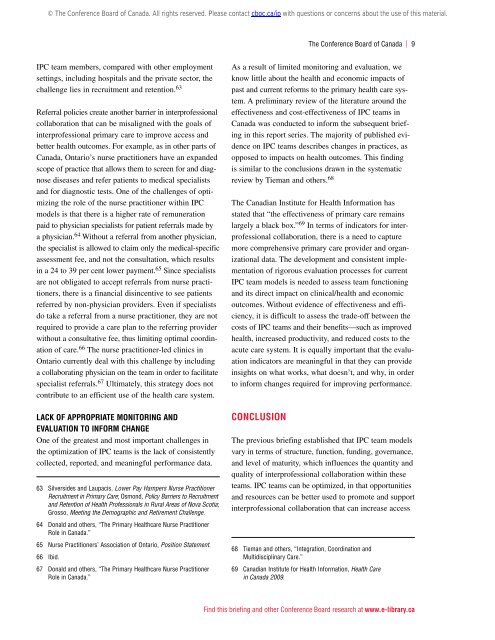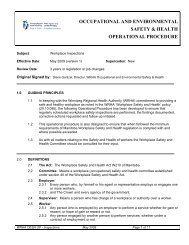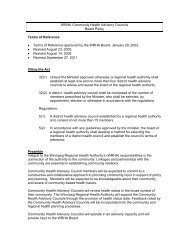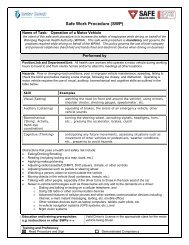Improving Primary Health Care Through Collaboration: Briefing 2 ...
Improving Primary Health Care Through Collaboration: Briefing 2 ...
Improving Primary Health Care Through Collaboration: Briefing 2 ...
- No tags were found...
Create successful ePaper yourself
Turn your PDF publications into a flip-book with our unique Google optimized e-Paper software.
© The Conference Board of Canada. All rights reserved. Please contact cboc.ca/ip with questions or concerns about the use of this material.The Conference Board of Canada | 9IPC team members, compared with other employmentsettings, including hospitals and the private sector, thechallenge lies in recruitment and retention. 63Referral policies create another barrier in interprofessionalcollaboration that can be misaligned with the goals ofinterprofessional primary care to improve access andbetter health outcomes. For example, as in other parts ofCanada, Ontario’s nurse practitioners have an expandedscope of practice that allows them to screen for and diagnosediseases and refer patients to medical specialistsand for diagnostic tests. One of the challenges of optimizingthe role of the nurse practitioner within IPCmodels is that there is a higher rate of remunerationpaid to physician specialists for patient referrals made bya physician. 64 Without a referral from another physician,the specialist is allowed to claim only the medical-specificassessment fee, and not the consultation, which resultsin a 24 to 39 per cent lower payment. 65 Since specialistsare not obligated to accept referrals from nurse practitioners,there is a financial disincentive to see patientsreferred by non-physician providers. Even if specialistsdo take a referral from a nurse practitioner, they are notrequired to provide a care plan to the referring providerwithout a consultative fee, thus limiting optimal coordinationof care. 66 The nurse practitioner-led clinics inOntario currently deal with this challenge by includinga collaborating physician on the team in order to facilitatespecialist referrals. 67 Ultimately, this strategy does notcontribute to an efficient use of the health care system.Lack of Appropriate Monitoring andEvaluation to Inform ChangeOne of the greatest and most important challenges inthe optimization of IPC teams is the lack of consistentlycollected, reported, and meaningful performance data.63 Silversides and Laupacis, Lower Pay Hampers Nurse PractitionerRecruitment in <strong>Primary</strong> <strong>Care</strong>; Osmond, Policy Barriers to Recruitmentand Retention of <strong>Health</strong> Professionals in Rural Areas of Nova Scotia;Grosso, Meeting the Demographic and Retirement Challenge.64 Donald and others, “The <strong>Primary</strong> <strong>Health</strong>care Nurse PractitionerRole in Canada.”65 Nurse Practitioners’ Association of Ontario, Position Statement.66 Ibid.67 Donald and others, “The <strong>Primary</strong> <strong>Health</strong>care Nurse PractitionerRole in Canada.”As a result of limited monitoring and evaluation, weknow little about the health and economic impacts ofpast and current reforms to the primary health care system.A preliminary review of the literature around theeffectiveness and cost-effectiveness of IPC teams inCanada was conducted to inform the subsequent briefingin this report series. The majority of published evidenceon IPC teams describes changes in practices, asopposed to impacts on health outcomes. This findingis similar to the conclusions drawn in the systematicreview by Tieman and others. 68The Canadian Institute for <strong>Health</strong> Information hasstated that “the effectiveness of primary care remainslargely a black box.” 69 In terms of indicators for interprofessionalcollaboration, there is a need to capturemore comprehensive primary care provider and organizationaldata. The development and consistent implementationof rigorous evaluation processes for currentIPC team models is needed to assess team functioningand its direct impact on clinical/health and economicoutcomes. Without evidence of effectiveness and efficiency,it is difficult to assess the trade-off between thecosts of IPC teams and their benefits—such as improvedhealth, increased productivity, and reduced costs to theacute care system. It is equally important that the evaluationindicators are meaningful in that they can provideinsights on what works, what doesn’t, and why, in orderto inform changes required for improving performance.ConclusionThe previous briefing established that IPC team modelsvary in terms of structure, function, funding, governance,and level of maturity, which influences the quantity andquality of interprofessional collaboration within theseteams. IPC teams can be optimized, in that opportunitiesand resources can be better used to promote and supportinterprofessional collaboration that can increase access68 Tieman and others, “Integration, Coordination andMultidisciplinary <strong>Care</strong>.”69 Canadian Institute for <strong>Health</strong> Information, <strong>Health</strong> <strong>Care</strong>in Canada 2009.Find this briefing and other Conference Board research at www.e-library.ca
















